Top 11 B2B Customer Engagement Strategies of 2026
Unlock the potential of B2B customer engagement. See how to turn every client interaction into an opportunity to inspire, educate and collaborate, driving the company toward prosperity..

Unlock the potential of B2B customer engagement. See how to turn every client interaction into an opportunity to inspire, educate and collaborate, driving the company toward prosperity..

When it comes to business-to-business (B2B) relationships, customer engagement is like the glue that holds everything together. Beyond transactional interactions, it has become a powerful strategic tool that companies are using to their advantage. B2B buyers value ease of finding a product, specialized content and user-friendly experience.
B2B customer engagement is not a choice anymore. It’s a vital strategy for companies striving to thrive in an ever-evolving business landscape. Engagement is all about building and nurturing meaningful, long-term relationships between businesses. Let us dive into the basics of B2B client engagement and then go through the best strategies!
B2B customer engagement refers to the ongoing relationship a business has their corporate clients. It encompasses all touchpoints throughout the customer journey, from initial awareness to post-purchase support and loyalty.
The process works by creating meaningful, personalized experiences for business clients across various channels. Companies use strategies like targeted marketing, customized solutions, account-based approaches and proactive customer service to establish strong connections. They leverage data analytics and CRM systems to understand client needs.
Key objectives:
So, what exactly are the advantages of elevating your customer engagement efforts in the B2B landscape? Let’s delve in to help you elevate your business to new heights.
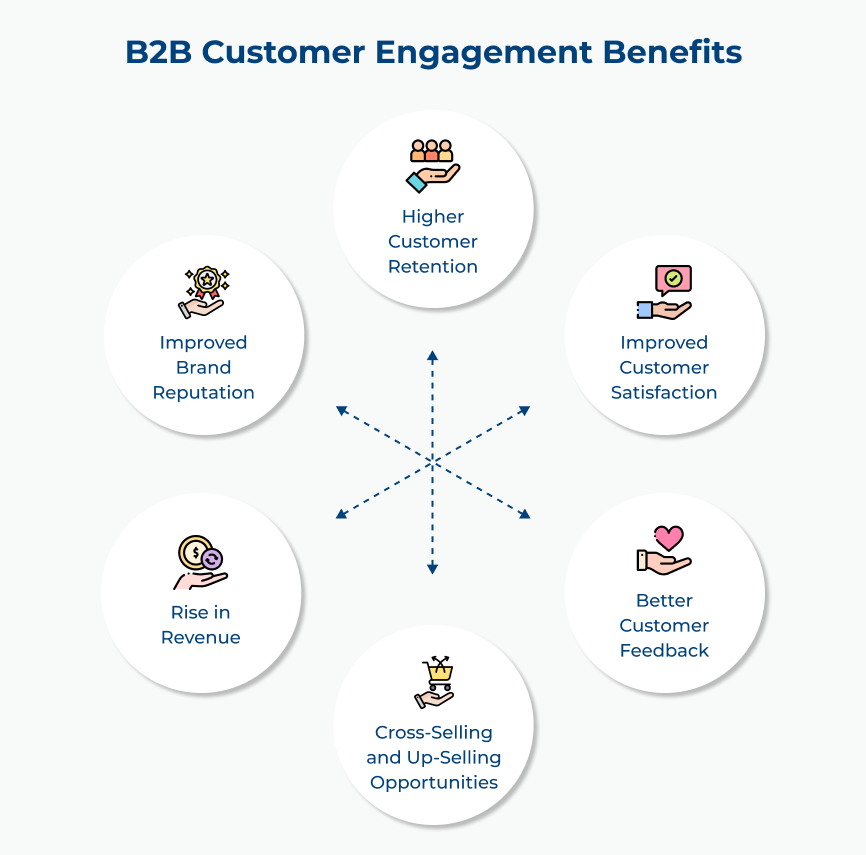
Engaged B2B customers are more likely to do business with a company again and again in the future. It is no secret that retaining customers is financially way better for businesses than getting new customers. 60% of leaders say customer service improves customer retention. Businesses can promote long-term customer retention by consistently engaging with their clients.
Businesses can provide individualized solutions that meet and exceed customers’ expectations by focusing on their pain points. It helps businesses stand out from their rivals and improves customer satisfaction. Satisfied customer benefits businesses both in the short term and long term.
Businesses have the potential to establish a solid brand reputation that distinguishes them from competitors in their sector through consistent engagement and exceptional service. It can help the company win over new customers and establish itself as a market leader.
Engaged B2B customers will likely bring more cash with a business and refer them to others. Companies have the potential to drive growth in their sector and increase revenue. Establishing solid relationships and providing exceptional service leads to a significant boost in revenue.
Businesses can gain valuable feedback and understanding of their customer’s preferences by regularly engaging with them. They can use the insights and feedback to tailor their offerings . The insights should be leveraged to refine their offerings to satisfy customer requirements better.
Cross-selling and up-selling opportunities are more likely to be accepted by engaged B2B customers. Businesses can identify new opportunities to offer additional offerings that meet customer needs by establishing credibility and trust with their customers.
Let us explore the top B2B customer engagement strategies that can help you build stronger relationships, enhance customer satisfaction and drive your business success.
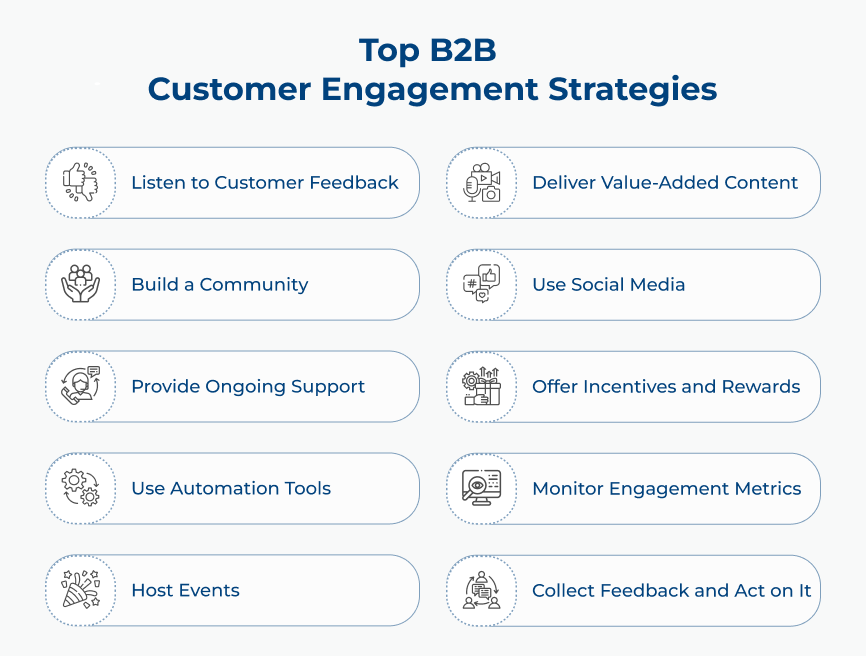
Actively seeks and uses customer feedback to tailor offerings to meet customer needs better. Improving customer satisfaction and driving growth starts with listening to customer feedback. 53% of the marketers also put customer feedback as the number one tactic to improve customer experience.
Continuously listening to customer feedback is similar to having a built-in compass guiding your business strategy. Implementing customer suggestions helps businesses enhance their offerings but also showcase their commitment to customers’ success.
Best Practices:
Proactive feedback collection: Actively seek out customer feedback through various channels, including surveys, emails, and direct interactions. Make it easy for customers to share their thoughts and experiences.
Implement actionable insights: Don’t just collect feedback; analyze it thoroughly and implement changes based on the insights received. Prioritize improvements that have the most significant impact on customer satisfaction.
Closed-loop feedback: Create a feedback loop by following up with customers after changes are implemented to show that their input is valued and that their concerns have been addressed.
Provide informative, relevant and valuable content that helps customers solve problems , helping them to achieve their goals. Offering value-added content enables businesses to position themselves as thought leaders and build a loyal following.
Value-added content isn’t just about informing your customers: it’s about empowering them. When the content becomes a resource that helps them solve problems, achieve their goals, or navigate industry challenges, businesses aren’t just seen as service providers but as trusted allies in the customer journey.
Best Practices:
Customer-centric content strategy: Develop content that directly addresses the pain points and challenges of your target audience. Ensure that your content is focused on solving problems and providing practical solutions.
Diverse content formats: Offer a variety of content formats, including blog posts, webinars, infographics, and videos, to cater to different customer preferences.
Content distribution strategy: Use data analytics to identify the most effective distribution channels for your content, ensuring that it reaches the right audience at the right time.
Promote a sense of belonging among customers. Provide opportunities for them to connect and share their experiences. Businesses can establish themselves as a trusted partner and build strong relationships with their customers through community-building initiatives.
Creating a community around your brand isn’t just about connecting customers; it’s about creating a shared identity. When customers feel like part of a larger community with shared values, it deepens their connection to the brand and makes them more likely to advocate for the business.
Best Practices:
Engage and participate: Actively engage in the community you’re building. Respond to discussions, answer questions, and encourage members to share their experiences.
Moderation and guidelines: Establish clear community guidelines to maintain a positive and respectful environment. Appoint moderators to enforce these guidelines and ensure healthy interactions.
Exclusive content and benefits: Provide exclusive content, events, or benefits to community members as a way to reward and recognize their loyalty.
Leverage social media to share valuable content, engage with customers, and build relationships with the target audience. Companies can use social media to reach a wider audience and increase brand awareness. Social media content is the most commonly used content type among B2B marketers, with 95% of them employing it.
Social media is your megaphone to the world. Effective B2B social media engagement is not just about broadcasting. It’s about starting conversations, sharing insights, and creating a space where your customers want to be.
Best Practices:
Content calendar: Develop a content calendar to ensure consistent posting and engagement on social media platforms. Plan and schedule posts in advance to maintain a regular online presence.
Engage authentically: When engaging with customers on social media, be authentic and transparent. Respond promptly to comments, address concerns openly, and maintain a genuine tone in your interactions.
Monitoring and analytics: Use social media analytics tools to track engagement metrics, such as likes, shares, and comments. Adjust your social media strategy based on data insights to maximize engagement.
Offer training, support, and resources to help customers succeed. Providing ongoing support allows businesses to position themselves as trusted partners and build long-term customer relationships.
Beyond the initial transaction, ongoing support is the thread that weaves customer relationships. It’s not just about resolving issues; it’s about being proactive, offering guidance and being there whenever your customers need a helping hand.
Best Practices:
24/7 availability: Offer support channels that are available round-the-clock, especially for international clients or those in different time zones. Ensure that customers can access help whenever they need it.
Self-Service resources: Create a comprehensive library of self-service resources, including FAQs, tutorials and knowledge bases. It helps to empower customers to find solutions independently.
Proactive Communication: Anticipate potential issues and proactively reach out to customers to offer assistance before they even realize they need it. The proactive approach demonstrates a commitment to customer success.
Provide discounts, special offers, or loyalty programs to incentivize customers to continue doing business with the company. Businesses can build customer loyalty and increase retention by offering incentives.
Beyond the initial transaction, ongoing support is the thread that weaves customer relationships. It’s not just about resolving issues; it’s about being proactive, offering guidance, and being there whenever the customers need a helping hand.
Best Practices:
Tiered loyalty programs: Implement tiered loyalty programs that offer increasing benefits as customers engage more with your business. It encourages long-term relationships and repeat business.
Exclusive discounts: Provide exclusive discounts or special offers to loyal customers, making them feel appreciated and incentivizing them to continue their partnership with your company.
Referral programs: Encourage satisfied customers to refer other businesses to your services by offering rewards or discounts for successful referrals, expanding your customer base while rewarding loyalty.
Automation tools are the silent partners in delivering a seamless B2B customer engagement model. Chatbots can offer instant responses, email automation can nurture leads, and social media scheduling ensures consistent communication.
Use tools such as chatbots, email automation and social media scheduling to streamline communication . They will help to provide a seamless customer experience. Automation tools not only save time and resources for both parties but also improve customer satisfaction.
Chatbot assistance: Implement chatbots to provide immediate responses to common inquiries, ensuring that customers receive timely assistance, even outside regular business hours.
Email automation: Use email automation to personalize content and offers based on customer preferences, improving conversion rates.
Social Media scheduling: Schedule social media posts in advance to maintain a consistent online presence and engage with your audience effectively, saving resources.
Track metrics like customer satisfaction, retention, and revenue to measure the effectiveness of engagement strategies as well as make the needed improvements. Monitoring engagement metrics allows businesses to identify areas for improvement and refine their strategy over time.
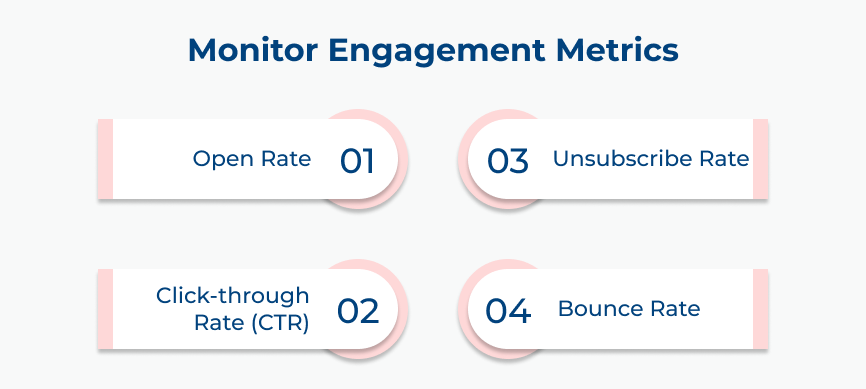
Analyzing the engagement metrics provides a clear picture of what’s working and what needs improvement. The process enables businesses to refine their approach to deliver even greater value to their current and potential customers.
Set clear goals: Establish specific goals for customer engagement metrics, such as increased customer satisfaction scores or higher retention rates. Having clear objectives helps focus your efforts.
Regular reporting: Generate regular reports on engagement metrics and share them with relevant teams. Use these reports to identify trends, successes, and areas for improvement.
Adapt and experiment: Based on the insights from engagement metrics, be willing to adapt your strategies and experiment with new approaches to continually improve customer engagement.
Hosting events is one of the most effective ways to improve and engage with B2B customers. Companies can consider hosting webinars, conferences, or even local events. Events are incredible for showcasing the offerings and connecting with customers face-to-face.
Hosting events is like opening the doors to a thriving marketplace of ideas and connections. Events also facilitate networking among the customers, providing them with a platform to learn from industry experts and each other, further solidifying their loyalty.
Best Practices:
Diverse event formats: Consider hosting a variety of events, such as webinars, conferences, workshops and networking sessions to cater to different customer interests.
Pre-event engagement: Build anticipation and engagement by promoting events well in advance through various channels, offering sneak peeks of what attendees can expect.
Post-event follow-up: After events, follow up with attendees, provide event resources and seek feedback to ensure a positive post-event experience.
Customer engagement continues even after the sale. It’s vital to collect feedback from the customers and act on it. It shows the customers that the company values their opinions and is willing to make changes to improve their experience.
Companies can collect feedback through surveys, feedback forms, or even social media. Once you’ve collected feedback, analyze it and implement changes to improve the customer experience. Taking the feedback becomes meaningless if the business doesn’t act based on it.
Best Practices:
Survey timing: Time your feedback surveys strategically to capture customer sentiment at key touchpoints, such as after a purchase, support interaction, or event participation.
Feedback analysis tools: Utilize feedback analysis tools to process large volumes of customer responses efficiently, uncovering valuable insights without overwhelming your team.
Actionable response: Ensure that customer feedback isn’t just collected but acted upon promptly. Demonstrate to customers that their input leads to tangible improvements in your products or services.
Promoting a culture of customer engagement across the company is extremely significant. It implies prioritizing customer engagement at all levels of the business and encouraging employees to provide a great customer experience.
Creating a culture of customer engagement allows the companies to ensure everyone across the company places the customers first. The business as a whole becomes focused on meeting their needs and exceeding their expectations.
Best Practices:
Leadership commitment: Engage leadership to champion and model a customer-centric culture, emphasizing the importance of customer engagement throughout the business.
Employee training: Provide training and resources to employees at all levels to enhance their customer engagement skills, ensuring that everyone is aligned with the customer-centric vision.
Recognition and rewards: Recognize and reward employees who consistently excel in customer engagement efforts, reinforcing the value of prioritizing customers across the companies.
Let us explore the best metrics that every business should monitor to ensure they are consistently meeting customer expectations and driving loyalty.
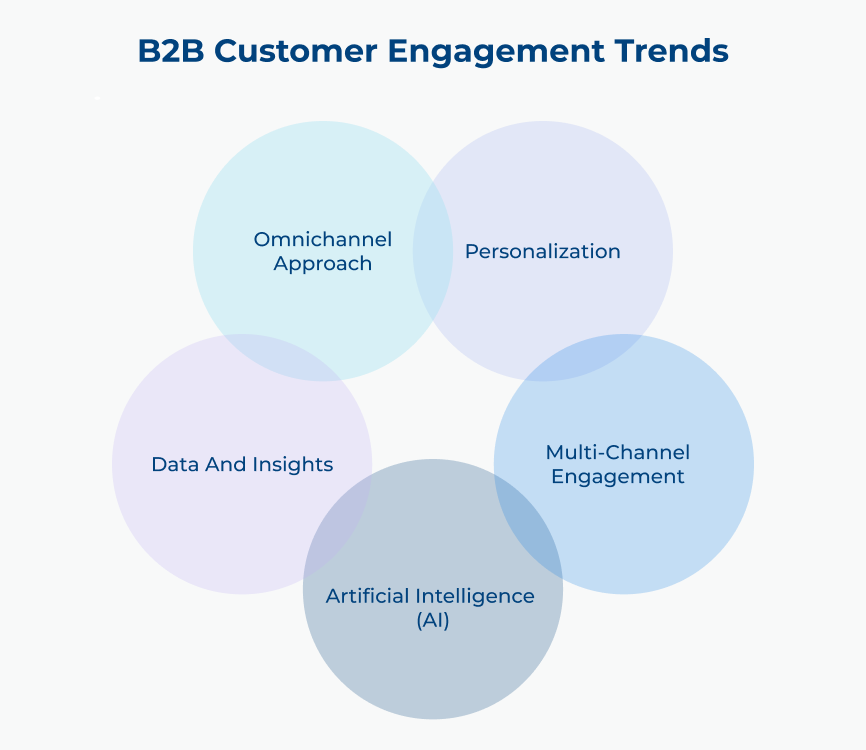
Omnichannel approach: One of the most significant trends is the omnichannel approach, which ensures that customers have a seamless and consistent experience across all channels. B2B businesses are using 10 unique channels to interact with their customers. Whether it’s email, social media, or live chat, businesses need to treat customers as people rather than just numbers.
Personalization: When it comes to B2B customer engagement trends, personalization is one of the biggest trends out there. It involves tailoring experiences to individual customers based on their behavior, preferences, and needs. Personalized emails are known to generate 50% higher open rates than non-personalized and generic emails.
Data and insights: Data analytics is also playing an increasingly important role in B2B customer engagement. Businesses can leverage the wealth of customer data available to better understand their behavior, needs, and preferences. They can provide relevant offers and recommendations that are more likely to resonate with customers.
Artificial intelligence (AI): Just like every other industry, AI has and will have huge significance in B2B. AI-powered chatbots are being used to provide 24/7 support and answer common customer queries. They enhance efficiency by handling routine tasks, allowing human agents to focus on more complex issues.
Multi-channel engagement: B2B customers interact with businesses through various channels, including social media, email, chat, and phone. Effective B2B customer engagement idea requires a seamless, omnichannel approach to ensure consistency and convenience. Businesses must ensure that customers get top-quality and consistent support across all channels.
Content marketing : High-quality content that educates and solves problems is essential for B2B customer engagement. Providing valuable resources, such as whitepapers, webinars, and expert insights, helps build trust. High-quality and eye-catching graphics should also be prepared to enhance the quality of the content.
Check out the real-world examples of B2B customer engagement strategies that have effectively trust, improved satisfaction and enhanced client loyalty.
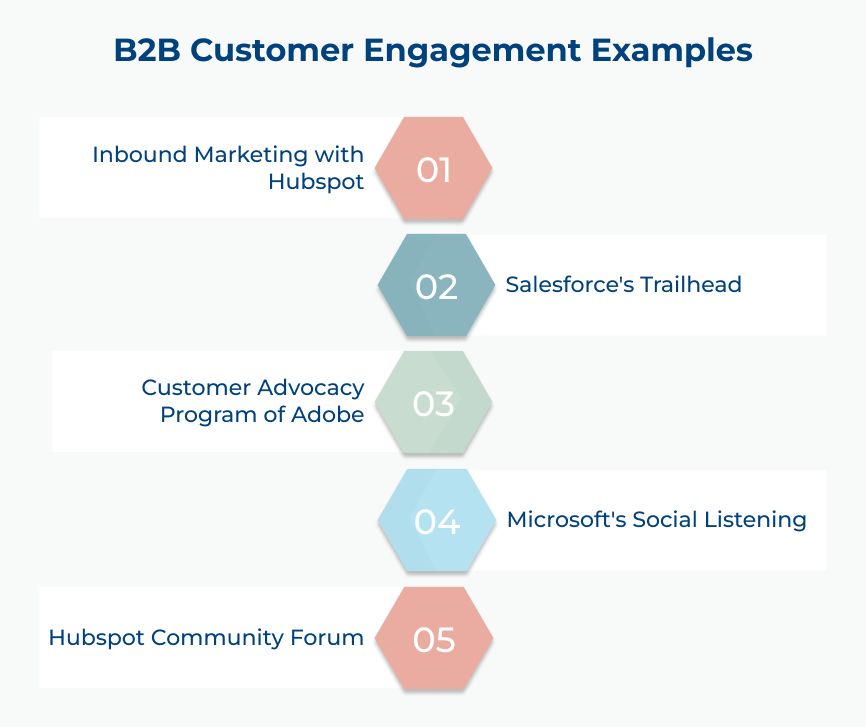
Hubspot is a pioneer in B2B customer engagement, focusing on the creation of useful content that piques the interest of prospective customers and keeps them engaged throughout the buying process. Traffic increased by 4.2 times for them and leads increased by three times as a result of their B2B customer engagement strategy.
Salesforce offers a remarkable customer engagement stage called Trailhead. It furnishes customers with a gamified opportunity for growth. Customers are motivated to learn more when they complete tasks related to Salesforce’s products and receive badges. The commitment system has brought about a 20% expansion in consumer loyalty and a 75% increment in item reception for them.
Adobe has always been the business that encourages its customers to participate in events and webinars as part of Adobe Insiders – the company’s customer advocacy program. Adobe’s customer satisfaction has increased by 50% and engagement with the customer community has increased by 35% as a result of this strategy.
Microsoft always has an eye on the social space. They look for mentions of their brand, products, and rivals on social media. Microsoft has seen a 20% increase in customer loyalty and a 25% increase in customer retention. It has been a result of real-time interactions with customers and responses to their concerns.
Hubspot’s community forum allows customers to get clarification on some pressing issues, share thoughts, and associate with other Hubspot customers. Embracing the approach has led to Hubspot’s product adoption increasing by 15% and customer satisfaction has increased by 24% as a result of the engagement strategy.
Explore common pitfalls in B2B engagement and provide actionable solutions to help you establish more productive connections that drive success.
Businesses can often find it challenging to comprehend the requirements and preferences of their customers. It can make it hard to make applicable and customized commitment systems.
Solution: Market Research
Gathering Customer Feedback and Preferences Market research can help businesses better understand customers’ needs. Targeted engagement strategies that resonate with customers may emerge.
A company’s department must communicate and work together seamlessly to engage B2B customers effectively. Siloed communication and coordination are problematic for many businesses, resulting in a disjointed customer experience.
Solution: Carry out a Collaborative Strategy
Carrying out a collaborative strategy that encourages cross-functional communication and coordination can assist companies here. It will allow them to deliver a consistent and steady customer experience. Customer loyalty and satisfaction may rise significantly as a result.
Personalization is becoming increasingly important to engage B2B customers. It is difficult for many businesses to tailor communications and experiences to each customer.
Solution: Leverage Data Analytics
Leverage data analytics can assist businesses with better figuring out their customers’ behavior, inclinations, and requirements. It may result in the creation of individualized strategies for engagement that resonate with distinct customers.
Successful B2B customer engagement frequently necessitates using technology, such as marketing automation or CRM software. Many companies often need the technology infrastructure to support such tools.
Solution: Put resources into the Innovation Framework
Putting resources into an innovation framework can assist businesses with better supporting their B2B customer engagement strategies. It can incorporate CRM programming, showcasing mechanization devices, and other innovation arrangements to customize commitment techniques.
Effective B2B customer engagement strategies require personnel, money, and resources like time. In any case, numerous organizations battle to allocate assets.
Solution: Prioritize Resource Allocation
Businesses can ensure they invest in the right areas by prioritizing resource allocation to support B2B customer engagement. It may entail hiring dedicated staff, allocating a budget to engagement strategies, and clearly defining objectives.
B2B customer engagement is essential for long-term success and growth. Businesses now have more opportunities to engage with their customers thanks to the most recent trends, such as omnichannel engagement, personalization, data-driven engagement, and interactive content.
A successful B2B customer engagement strategy can take time to implement. Recognizing the opportunities and carrying out adequate procedures, companies can expand their return for money invested and lay areas of strength for their B2B customers. Businesses can promote loyalty, boost retention rates, and drive growth by focusing on engagement.
Keeping B2B customers engaged is achieved through a multi-faceted approach. Personalization is key so businesses should tailor their offerings to meet individual customer needs. Providing high-quality content keeps customers informed and engaged. Consistent communication across various channels maintains an open dialogue. Actively seeking customer feedback and acting upon it is crucial to make necessary improvements.
Technology plays a massive role in elevating B2B customer engagement. Tools such as Customer Relationship Management (CRM) systems help businesses track interactions, manage leads and personalize outreach effectively. Marketing automation platforms can help deliver relevant content and campaigns at the right time. Analytics tools also provide valuable insights into customer behavior and preferences, allowing businesses to fine-tune their strategies continuously.
Customer engagement in B2B can be measured through various metrics such as website traffic, time spent on site, social media interactions, email open rates and click-through rates. Measuring lead quality, customer satisfaction surveys and tracking customer behavior through marketing automation platforms can provide valuable insights into customer engagement. It is important to analyze and monitor the metrics consistently to gauge the effectiveness of B2B customer engagement strategies.
B2B customer engagement is crucial because it helps build strong relationships between businesses, leading to increased loyalty, repeat business and referrals. Engaged customers are more likely to provide valuable feedback, which can aid in product development and improvement. Actively engaging with customers allows businesses to better understand their needs and preferences, resulting in more effective marketing strategies.
B2B client management is essential for sales because it directly impacts the success and profitability of a business. Effective client management helps build strong relationships, understand customer needs and deliver tailored solutions. Prioritizing client retention allows businesses to drive repeat sales and long-term partnerships, eventually boosting business growth.

Market better, sell faster and support smarter with Veemo’s Conversation Customer Engagement suite of products.
Unify all your customer data in one platform to deliver contextual responses. Get a 360 degree view of the customer lifecycle without switching tools.
Connect with the tools you love to reduce manual activities and sync your business workflows for a seamless experience.
 https://veemo.io/wp-content/uploads/2024/12/customer-service-response-time.png
1256
2400
Webvision Solution
https://veemo.io/wp-content/uploads/2024/11/veemo.svg
Webvision Solution2025-10-17 10:51:142025-10-17 10:51:149 Effective Tips to Reduce Customer Service Response Time
https://veemo.io/wp-content/uploads/2024/12/customer-service-response-time.png
1256
2400
Webvision Solution
https://veemo.io/wp-content/uploads/2024/11/veemo.svg
Webvision Solution2025-10-17 10:51:142025-10-17 10:51:149 Effective Tips to Reduce Customer Service Response Time https://veemo.io/wp-content/uploads/2024/10/How-to-Create-Knowledge-Base.png
1257
2400
Vikas Sachan
https://veemo.io/wp-content/uploads/2024/11/veemo.svg
Vikas Sachan2024-10-21 12:24:342025-11-03 07:13:21How to Create a Knowledge Base in 9 Easy Steps: The Ultimate Guide
https://veemo.io/wp-content/uploads/2024/10/How-to-Create-Knowledge-Base.png
1257
2400
Vikas Sachan
https://veemo.io/wp-content/uploads/2024/11/veemo.svg
Vikas Sachan2024-10-21 12:24:342025-11-03 07:13:21How to Create a Knowledge Base in 9 Easy Steps: The Ultimate Guide https://veemo.io/wp-content/uploads/2024/02/Live-Chat-for-Sales.png
628
1200
teamwebvisionsolution@gmail.com
https://veemo.io/wp-content/uploads/2024/11/veemo.svg
teamwebvisionsolution@gmail.com2024-10-21 11:31:222025-08-06 10:22:06How to Use Live Chat for Sales? 7 Proven Ways to Grow Revenue
https://veemo.io/wp-content/uploads/2024/02/Live-Chat-for-Sales.png
628
1200
teamwebvisionsolution@gmail.com
https://veemo.io/wp-content/uploads/2024/11/veemo.svg
teamwebvisionsolution@gmail.com2024-10-21 11:31:222025-08-06 10:22:06How to Use Live Chat for Sales? 7 Proven Ways to Grow RevenueGrow Customer Relationships and stronger team collaboration with our range of products across the Conversational Engagement Suite.

 How to Use Live Chat for Sales? 7 Proven Ways to Grow Revenue
Scroll to top
How to Use Live Chat for Sales? 7 Proven Ways to Grow Revenue
Scroll to top